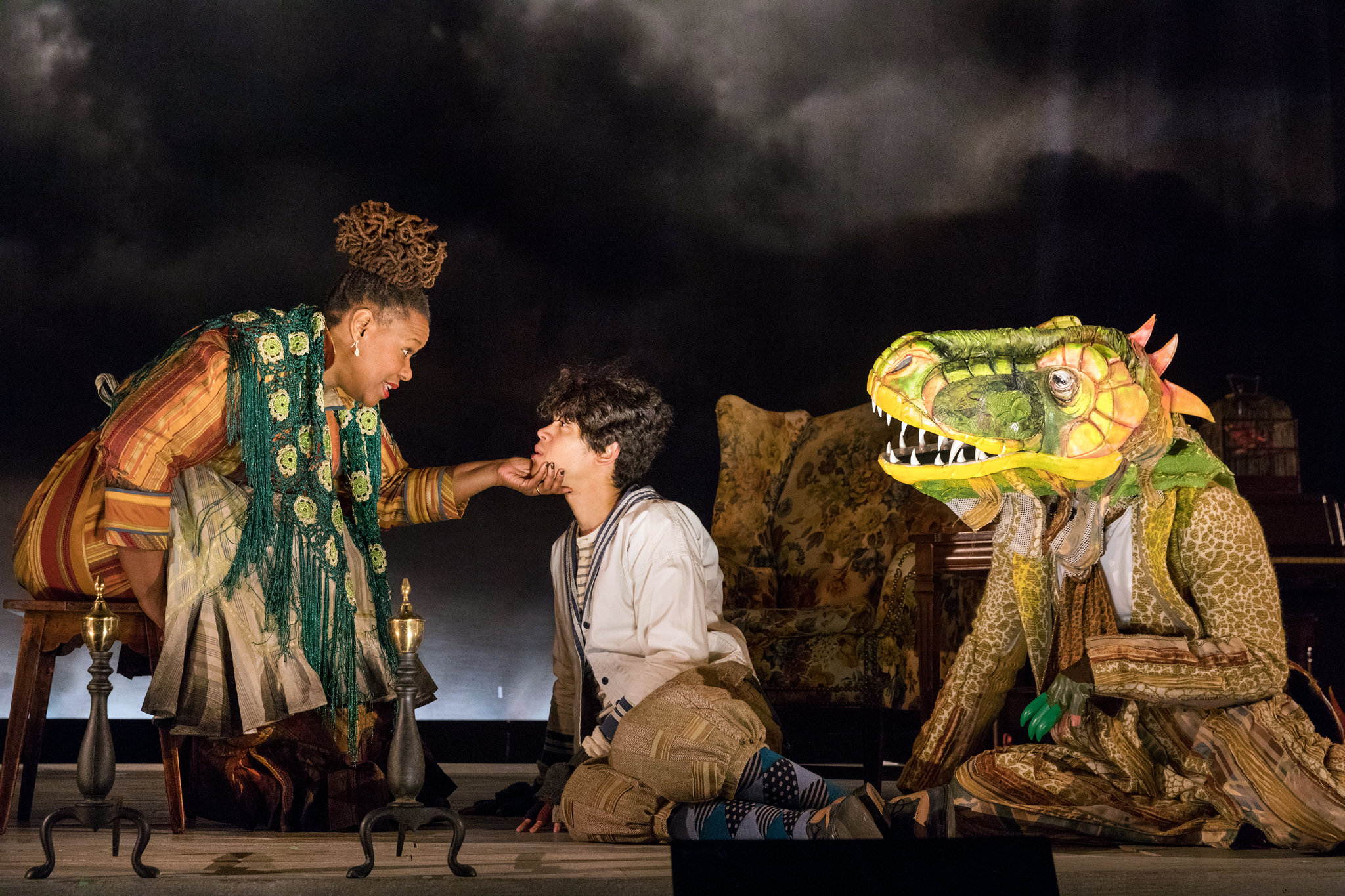Why Thornton Wilder Matters in the Trump Era
by LAURA COLLINS-HUGHES reprinted from The New York Times
When Thornton Wilder’s “The Skin of Our Teeth” had its Broadway premiere in 1942, directed by Elia Kazan and starring a dream cast led by Tallulah Bankhead and Fredric March, the critic Brooks Atkinson of The New York Times called it “one of the wisest and friskiest comedies written in a long time.” When it returned in 1955, with Helen Hayes and Mary Martin, Mr. Atkinson deemed it simply “perfect.”
After that, though, the play’s fortunes fell. On its third and most recent Broadway outing, José Quintero’s 1975 revival starring Elizabeth Ashley, the Times critic Mel Gussow dismissed it as “simplistic.” Boundary-breaking in its day, it has long been scarce on professional stages.
So Arin Arbus’s new Off Broadway production for Theater for a New Audience, in previews at the Polonsky Shakespeare Center in Brooklyn, is a rare chance for re-evaluation. With a cast of 35 (!) and original music by César Alvarez (“Futurity”), it follows the members of the Antrobus family of suburban New Jersey through the ice age in Act I (their pets are a mammoth and a dinosaur; freezing refugees clamor at the door) and into a great flood in Act II. The third act opens amid the ruins of a war. With each calamity, the Antrobuses have to figure out whether and how to survive.
Jeffrey Horowitz, the founding artistic director of Theater for a New Audience, said he didn’t choose the play with topicality in mind. But Wilder had his own suspicions about when it resounds most powerfully. As he explained in the 1950s, in a preface to his collection “Three Plays”: “It was written on the eve of our entrance into the war and under strong emotion, and I think it mostly comes alive under conditions of crisis.”
Several admirers of the play spoke recently about why “The Skin of Our Teeth” endures, what makes it problematic and why this could be a ripe time for its resurgence. Here are edited excerpts from those interviews.
Carey Perloff
The artistic director of American Conservatory Theater in San Francisco directed “The Skin of Our Teeth” at Classic Stage Company in New York in 1986 — a production that, according to Mr. Gussow’s review in The Times, included the refugees in Act I singing a chorus of “Tomorrow,” from “Annie.” Ms. Perloff laughed as she said she didn’t recall much about that long-ago detail, but she was very clear on the play’s current resonance.
All of us who are running theaters now are in this strange position of thinking: What is the appropriate response to the chaos and uncertainty of this moment, and how do you think about that theatrically? It was very prescient of Jeffrey to program this.
I think the reason this one keeps coming back is that it is an allegory, so it has those deep biblical roots and kind of archaeological references. It’s a very profound play to rehearse, because those epic questions come up as you work: Is humanity resilient? It’s a really dystopian look at the American experiment, and I think that’s what we’re all kind of waking up to. We assumed we would be inheritors of this great ideal, and now we realize how completely fragile it is.
There are great things in the play, and there are really frustrating things in the play. As with many great theatrical artifacts, you sort of wish you could take it apart and recombine it somehow. Sometimes I think we should give ourselves permission to do important plays even if they don’t really work.
Paula Vogel
“The Skin of Our Teeth” is the first play that the playwright (“Indecent”) ever saw, at her public high school in Maryland in the 1960s. A self-described “huge fanatic about Thornton Wilder,” she regards it as an example of near perfection and said it has been deeply influential on emerging writers over the past 40 years. Ms. Vogel, a Pulitzer Prize winner, considers the play — with its reverence for books and great thinkers, represented by Mr. Antrobus’s cherished personal library — a defense of Western humanism.
In my life, I’ve only seen two productions of it. One of the difficulties is that commercial and mainstream American drama has eschewed Wilder’s more global, abstract, philosophical voice for a kind of nitty-gritty naturalism, which doesn’t critique American society the same way that Wilder does. What I think happens is that there is a critical reprimand for choosing mythic elements and allegorical elements in American theater.
It’s an extraordinary time to be producing this play. We’re in this moment in time where we are thinking again very apocalyptically. A, we’re having extreme climate change; B, we’re having floods; C, we’re having refugees; and D, we’re actually facing the extinction of animals on our planet, and then hanging over us is the perpetual warfare. Everything in the play is pretty much upon us.
Obviously he’s writing on the brink of huge apocalypse, of World War II and Hitler, and he’s saying: “Let’s look at the resistance. Let’s look at the fact that we are going to get through this, and let’s look at what we need to get through it. What we need are our books.”
Arin Arbus
Ms. Arbus first encountered “The Skin of Our Teeth” in 2002, when the nation was still reeling from 9/11, and immediately wanted to direct it. “I thought, If I don’t do it soon, it just won’t be relevant anymore,” she said, and laughed with what sounded like ruefulness. She agrees with Wilder that the play comes alive in times of crisis, but she believes it is staged as rarely as it is partly because of its complex requirements, including a large cast and the need to balance multiple theatrical styles while leaving room for Wilder’s humor.
One of the challenges and the thrills of it is the slippery style of the play: We go kind of without transition from a Brechtian theater, in which the emotional climax of the scene is broken and commented upon, into absurdist drama with lines like “Have you milked the mammoth?” into this dark domestic family tragedy. Unlocking that is hard.
He was writing it as the world was descending into chaos. I think everybody was wondering: “Will we get through this? And if we do, what then? Will we learn anything? Will we grow or change or do it better the next time?” Although the characters do grow and they survive, they are not transformed. Evil — quote-unquote evil — remains within the nation and within the family and within the home.
Things keep falling apart, and these characters have to go through it over and over and over and over again. That’s what it’s about. The characters are continually hitting rock bottom and then finding a way — and it’s usually with the help of other people — to have the hope to move forward, despite the catastrophic situation that is facing them in that immediate moment.
Bartlett Sher
The Tony-winning director, whose “Oslo” opens on Broadway this spring, has immersed himself twice in the Wilder play: first as an assistant to the director Robert Woodruff on a Guthrie Theater production in Minneapolis in 1990, then on his own Intiman Theater staging in Seattle in 2007. He cast the deaf actor Howie Seago in the role of Mr. Antrobus — in part, Mr. Sher said, to add “another layer of Joycean logic” to the play. He has great affection for Wilder, for both his experimental nature and his capacious heart, but that didn’t make staging the play any easier.
It’s a hard, hard, hard, hard show. It’s all based on “Finnegans Wake.” He was reaching for a kind of narrative in the structure that he put together that’s incredibly interesting but which I’m not sure he was totally successful at accomplishing. It’s one of those things that everybody’s really drawn to, how much they can’t wait to do it, and then they find out how hard it’s going to be.
It has a comforting and profound view of time. It makes you think of time over a very long arc. Right now we’re all freaking out and exploding over the particular kind of time that 2017 appears to be. But if you cycle way back, you think: “Well, yes, we’re going through an incredibly bumpy period in the republic, but it’s not impossible that the institutions will survive and come out reinvigorated.”
The primary job of interpreting the classics — absolutely primary job — is to discover the immediate significance of the work in the time you’re doing it. It’s interesting that Arin is doing it now, because I tend to think these works come around when you need them. It may be one of those things where this particular time requires a good “Skin of Our Teeth” to help make sense of it.
Photo: From left, Kecia Lewis, Reynaldo Piniella and Fred Epstein in “The Skin of Our Teeth,” a Theater for a New Audience production in Brooklyn. Credit: Richard Termine for The New York Times

